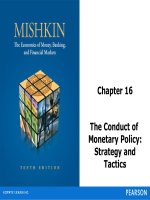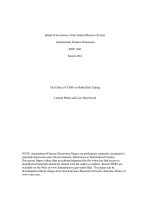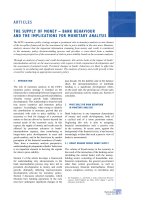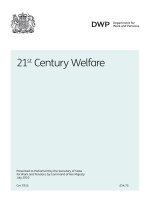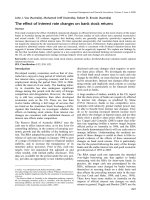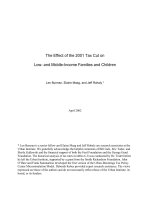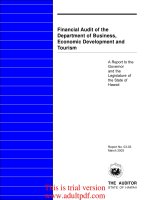The effect of suppliers market orientation and suppliers environmental conditions on manufacturers trust
Bạn đang xem bản rút gọn của tài liệu. Xem và tải ngay bản đầy đủ của tài liệu tại đây (1.01 MB, 72 trang )
MINISTRY OF EDUCATION AND TRAINING
UNIVERSITY OF ECONOMICS HOCHIMINH CITY
CHUNG NGOC HIEU
THE EFFECT OF SUPPLIER’S MARKET
ORIENTATION AND SUPPLIER’S ENVIRONMENTAL
CONDITIONS ON MANUFACTURER’S TRUST
Major
:
Business Administration
Major Code
:
60.34.05
MASTER OF BUSINESS ADMINISTRATION THESIS
Supervisor: Dr. Nguyen Dinh Tho
HOCHIMINH CITY - 2012
ACKNOWLEDGEMENTS
First gratefulness to,
Dr. Nguyen Dinh Tho,
This thesis would not have been possible unless his helps to supervise me.
For his wise knowledge and kindly patience, he remained forever in my respect.
Second gratefulness to,
My colleagues & benefactors in Nestle, Unilever, Coca Cola, Rich, Masan, Doan Ket,
Vinamilk, Vina Australia Packaging Labels Co, InterPet Group, Van Don Plastic,
Rang Dong Plastic, VinaPlast, Imperial Tobacco, BAT, Kimberly Clark, Tracimexco,
Hapro Group, Binh Vinh, Crown, Hercules, Ngoc Nghia Plastic, Bao Van…..
For their dedicated supports in questionnaire surveying and answering.
Last but not least, gratefulness to,
My family, for always being in my side.
ABSTRACT
This study is desired to investigate about the effect of supplier‘s market
orientation and environmental conditions on manufacturer’s trust and was taken the
survey in Ho Chi Minh and some South province markets. The main variables
included supplier’s market orientation with three inside variables as customer
orientation,
competitor
orientation,
and
inter-functional
coordination;
and
environmental conditions contained two variables as market turbulence and
competitive intensity.
From many previous researches about supplier’s market orientation and trust on
manufacturer, some main variables have been extracted and selected to synchronize
with Vietnamese conditions and after passing the pilot interview with the quantitative
method, main variables have been selected for taking the survey for this study. About
300 questionnaire forms have been sent out to 300 respondents who are managing
their enterprises in Ho Chi Minh city and south provinces, included Long An, Binh
Duong, Dong Nai, about 180 sets have been answered and returned in which 150 sets
have satisfied the purpose of the research. The findings from a sample of 150 sets have
revealed that the supplier‘s market orientation and environmental conditions has a
positive influence on manufacturer’s trust.
After analyzing by the Reliability between variables (Cronbach Alpha),
Correlation (Exploring Factor Analysis) and test Multiple Regression Model, the
research’s results indicated that the supplier’s customer orientation variable and
environmental conditions affect significantly on manufacturer’s trust.
i
CONTENTS
CHAPTER 1: INTRODUCTION
1.1 Research background .................................................................................................. 1
1.2 Problem statement....................................................................................................... 3
1.3 Research question and objective ................................................................................. 4
1.3.1 Research question .......................................................................................... 4
1.3.2 Research objective......................................................................................... 4
1.4 Research delimitation ................................................................................................. 4
1.5 Research methodology................................................................................................ 5
1.6 Research implications ................................................................................................. 6
1.7 Thesis structure ........................................................................................................... 6
CHAPTER 2: LITERATURE REVIEW
2.1 Market orientation and supplier’s market orientation ................................................ 8
2.1.1 Customer orientation ........................................................................................... 9
2.1.2 Competitor orientation ...................................................................................... 10
2.1.3 Inter-functional coordination ............................................................................ 10
2.2 Environmental conditions - Market turbulence and Competitive intensity ............ 11
2.3 Trust and manufacturer’s trust .................................................................................. 12
2.3.1 Trust ................................................................................................................. 12
2.3.2 Manufacturer’s trust .......................................................................................... 12
2.4 Theoretical model ..................................................................................................... 12
2.4.1 Independent Variables ..................................................................................... 13
2.4.2 Dependent Variable ......................................................................................... 13
2.4.3 Theoretical model and Hypotheses .................................................................. 14
2.4.3.1 Theoretical model.......................................................................................... 14
2.4.3.2 Research hypotheses ..................................................................................... 14
2.5 Summary .................................................................................................................. 15
CHAPTER 3: RESEARCH METHODOLOGY
3.1 Research design ........................................................................................................ 16
ii
3.1.1 Pilot test............................................................................................................... 16
3.1.2 Main survey......................................................................................................... 16
3.1.2.1 Sample size .................................................................................................... 17
3.1.2.2 Research process ........................................................................................... 17
3.2 Measurement validation ........................................................................................... 18
3.2.1 Measures of Customer orientation ...................................................................... 18
3.2.2 Measures of Competitor orientation .................................................................. 18
3.2.3 Measures of Inter-functional coordination ......................................................... 19
3.2.4 Measures of Market turbulence and Competitive intensity ................................ 19
3.2.5 Measures of Trust................................................................................................ 20
3.3 Summary .................................................................................................................. 21
CHAPTER 4: DATA ANALYSIS AND RESULTS
4.1 Descriptive data analysis .......................................................................................... 22
4.2 Testing factors of research model ............................................................................ 23
4.2.1 Cronbach Alpha Reliability Analysis ................................................................. 24
4.2.2 Exploring Factor Analysis (EFA) ....................................................................... 25
4.2.2.1 EFA results of the independent variables...................................................... 25
4.2.2.2 EFA results of the dependent variables ......................................................... 27
4.3 Hypotheses Testing .................................................................................................. 27
4.3.1 Testing Assumptions of Multiple Regression ................................................... 27
4.3.2 Testing hypotheses between Independent Variables and Dependent variable . 28
4.4 Summary ................................................................................................................... 31
CHAPTER 5: CONCLUSIONS
5.1 Overview .................................................................................................................. 32
5.2 Main findings ........................................................................................................... 32
5.3 Theoretical Implications ........................................................................................... 35
5.4 Managerial Implications ........................................................................................... 35
5.4.1 Supplier’s customer orientation .......................................................................... 35
5.4.2 Supplier market turbulence ................................................................................ 39
5.5 Further research ....................................................................................................... 41
References ......................................................................................................................... 42
iii
Appendices ....................................................................................................................... 51
Appendix 1: Questionnaire Form for Pilot Test ........................................................... 51
Appendix 2: Questionnaire in Vietnamese ................................................................... 52
Appendix 3: Questionnaire in English ......................................................................... 54
Appendix 4: EFA results of independent variables ..................................................... 56
Appendix 5: EFA results of dependent variable........................................................... 58
Appendix 6: Testing assumptions of multiple regression ............................................ 59
Appendix 7: Multiple Regression Line results ............................................................. 60
Appendix 8: Histogram, Normal P – P plot and Scatter plot ....................................... 61
iv
LIST OF FIGURES
Figure 2.4: The conceptual model of the effect of supplier’s market orientation and
supplier’s environmental conditions on manufacturer’s trust ........................................... 14
Figure 3.1: Research process. ............................................................................................ 17
Figure 4.4 Histogram, Normal P – P plot and Scatter plot of Dependent Variable Trust ................................................................................................................................... 57
v
LIST OF TABLES
Table 3.1: Scale of Customer orientation ....................................................................18
Table 3.2: Scale of Competitor orientation .................................................................19
Table 3.3: Scale of Inter-functional coordination........................................................19
Table 3.4: Scale of Environment conditions ...............................................................20
Table 3.5: Scale of Trust..............................................................................................20
Table 4.1: Sample characteristics ................................................................................23
Table 4.2: Cronbach Alpha of observed variables ......................................................24
Table 4.2.2: EFA for independent variables ................................................................ 26
Table 4.3: Multi regression between independent variables and dependent variables 28
Table 4.4: Anova between independent variables and dependent variables .............. 29
Table 4.5: Coefficients between independent variables and dependent variables ..... 29
vi
ABBREVIATIONS
MO: Market Orientation
EFA: Exploring Factor Analysis
MRL: Multiple Regression Model
1
CHAPTER 1: INTRODUCTION
The introduction chapter identify the research background, present the problem
statement, the research questions, and introduce the research methodology, the objectives as
well as limitation of the study. Furthermore, the significance of the research problem and thesis
structure is also outlined.
1.1 Research background
Market Orientation is one of the most important concept in modern marketing (Pandelica et
al., 2009). This concept has been researching and developing during past two decades (Brettel et
al., 2008). Most of these researches and studies are concentrated on the components of market
orientation and the relationship between market orientation and the firm’s business results.
Although these researches were studied from variety of fields and categories, many developed
and developing countries, many results founds that market orientation had such positive effects
with business results (Pandelica et al., 2009). In Vietnam, the research also record that market
orientation can explain up to 30% the firm business results (Hung and Hau, 2007). Vietnam
economic policies nowadays have been re structuring and developing as market orientation. This
step brings for Vietnam to become such very brilliant business environment, attracts the foreign
investments to innovate the technique in many fields so far to impulse the development of
economy, especially for the transitional economy in Vietnam now. However, from the past two
decades, the market orientation concepts has not been populated correspondingly in Vietnam (
Hac and Nghi, 2006). This is considered such as big challenge for Vietnam’s enterprises both
are private or government companies, especially when Vietnam is joining WTO.
In the literature, market orientation is born from the western – where these concepts
nowadays are continuing and leading in the world. Kohli and Jaworski (1990) conceptualized
Market orientation as the implementation of the marketing concept and developed a measure
(Kohli et al., 1993) that focused on the firm’s activities and behaviors regarding customer needs,
competitive information, market intelligence, and the sharing information among organizational
functions. Narver and Slater (1990: 21) offer a similar view, suggest that market orientation
2
consists of three behavioral components (customer orientation, competitor orientation, and inter
functional coordination), etc… From some research ( Tsui, 2004; Lau., 2002; Rousseau & Fried,
2001), they gave the comment for the global knowledge/value of market orientation concept as
western literature results are not enough. They suggest for the contributions from other
continents such as South America, Africa or Asia, especially from the impressive developing
countries such as Malaysia, Vietnam, Thailand, India and China (Tsui, 2004, p.492). However,
there is not much research focus on this concept so as to assess, evaluate and investigate
comprehensively it with the business operations or identify the market orientation components
so as to apply effectively to specific business culture in Vietnam. Or, with the management
team, in case they would like to invest to improve their market orientation, which factors they
must contribute or focus on.
On the other side, supply chain management also is a fresh category in Vietnam. With the
current world wide economy context, managing such good supply chain allows companies to
deal with daily challenges related to production, suppliers, retail, inventory, sales, product check
and delivery, warehouse operation among other or maximize the use of their resources including
finance and human capital. From this, the relationship between supplier and manufacturer takes
a very important role; contribute as a link in a chain since input and output of a company. This
relation is not simply a transaction “buy – sell” as before, but now, it becomes an integral part of
business to business operations. Global competition, tough local market, financial crisis…have
affected to all the firms in the business environment. These pressures have encouraged the firms
come to decision to decrease their investments in traditional channels, finding alternative
(Arthur Andersen & Co., 1995; Frazier and Antia, 1995). Toward to this, the company will be
very particular on their relations, especially in choosing their suppliers. In the relation with their
supplier, they tends to develop relation with few but selective suppliers ( Kalwai & Narayandas,
1995) and these suppliers have to have ability to response to their requirements, satisfy company
needs and contribute to the value of the customers.
From these reasons, this research is studied to answer for above problems. By putting the
market orientation concept to the relationship between supplier and manufacturer and by using
the market orientation component as Narver and Slater (1990) to investigate the market oriented
3
supplier in relations with their customer (manufacturer), the specific targets are verified the
affects of market orientation components and environment challenge to the relationship between
supplier and manufacturer.
1.2 Problem statement
This theoretical model is based on literature review, in which previous research
demonstrated that market orientation affects positively the level of customer’s trust (Morgan and
Hunt, 1994). The literature suggests market orientation companies increase value for customers
(Day, 1994), therefore, these constructs drive more satisfactions for customers (Anderson et al.,
1990) and consequently more trust (Morgan and Hunt, 1994). As observed by (Luhmann, 1988),
trust is used to reduce the complexity of the absent and gain positive expectation and get
competitive advantages and to differentiate themselves on the market place. This study explores
the effects of market orientation and environmental conditions of a firm to their customer’s trust
over the seller - buyer relationship.
Narver and Slater (1990) identifies three market orientation components as customer
orientation, competitor orientation, and inter-functional coordination, therefore, the supplier’s
market orientation also contain three above components. A market-oriented supplier, can be
defined as a customer-focused and goal-oriented firm (George and Weimerskiirch, 1998),
throughout their activities, understands well the customer’s needs and satisfies them; always
knows well about strengths and weaknesses, capabilities and strategies of their key current and
potential competitors (Narver and Slater 1990) and the firm can being responsive to
competitor’s activities (Balakrishnan 1996); and, internally, the information is transferred
thoroughly across all departments with the same purpose of serving for customer needs. A
market oriented supplier can contribute many values to their customers and enrich the
customer’s profits. Besides, the literature also recommend as supplier’s environmental factors
significantly mediatory influence to their customer’s trust. In this research, market turbulence
and competitive intensity in the supplier are stated to influence to manufacturer’s trust.
The literature recommends these variables are very significant, so, the author decides
include all of them on the conceptual model, is to understand the level of supplier’s market
orientation affects on manufacturer’s trust. The empirical test which proposed through the
4
hypotheses might provide evidences on how supplier’s customer orientation, supplier’s
competitor orientation, supplier’s inter-functional coordination, market turbulence and
competitive intensity affect positively the manufacturer’s trust.
1.3 Research question and objective
1.3.1 Research question
Consequently, based on the problem statement and the overall research framework, the
main research question of this research is needed to be answered as follows:
► What the key determinants affect on manufacturer’s trust? By evaluating the influence
level of the factors on manufacturer’s trust, the importance of focusing on market
orientation shall be highlighted to eventually help the supplier company heads
identify the right direction of their management and keep their customers under a
tough competitive environment.
1.3.2 Research objective
Based on this above research question, the objective of this study is outlined to examine
the affect of market orientation on manufacturer’s trust. Specially, it explores:
► The impact of Supplier’s Customer Orientation, Supplier’s Competitor Orientation,
Supplier’s Inter-Functional Coordination, Supplier’s Market Turbulence and
Supplier’s Competitive Intensity on Manufacturer’s Trust.
1.4 Research delimitation
The research was narrowed down to Ho Chi Minh city and three Southern provinces as
Binh Duong, Dong Nai and Long An. However, they are locating variety of manufacturers in
their industrial zones therefore, the taken samples from these areas can represent for whole
Vietnam. The research focused on manufacturers which produced the physical products, the
products categories such as services and banking, financial services were not included in this
study.
5
This study was narrowed by surveying in supplier site and manufacturer perceived the
trust from supplier. Data was collected from a single informant in the supplier companies. This
is a common practice in marketing research (Philips, 1981). Kumar et al. (1993) have suggested
that choosing the appropriate key informant could alleviate some of the potential problems.
Then, questionnaires which were sent to member of management team or head of departments
such as marketing or sales, did not indicate large differences between the key informant's view
of the relationship and the view of others involved in the relationship, providing support for the
validity of data collected solely from supplier informants.
This study explored the supplier’s market orientation affects on manufacturer’s trust.
From this step, further researches can extent more to manufacturer’s long term orientation come
to strengthen significantly the relationship between the seller and buyer in nowadays
competitive business environment.
1.5 Research methodology
From the relationship between the supplier and the manufacturer, this research studied a
part of this relation as the manufacturer’s trust under the effect of the market orientation of
supplier. The research went through two phases: (1) an exploratory study and (2) a main survey.
In exploratory study, a qualitative study was undertaken by a pilot survey. Collected information
was used to explore, adjust, and supplement to the measuring scale of the factors affected on
manufacturer’s trust for supplier’s market orientation.
The main survey was conducted by quantitative research in the form of questionnaire.
The result of questionnaire data was presented in the numerical form such as the age groups, job
level of respondents who attended this survey, time for doing business with manufacturer and
others. These numbers were, then, demonstrate in tables, graphs or other forms of statistics.
Conducted in Ho Chi Minh city and some areas nearby were to confirm the components as well
as value and reliability of the measuring scales of manufacturer’s trust. Cronbach alpha
coefficient, Exploring Factor Analysis (EFA), and Multiple Linear Regression analysis (MLR)
were applied through SPSS software; and convenience sampling was used.
6
1.6 The research implications
This study has several important implications for both practical business (head of
enterprises, marketing managers…of both suppliers and manufacturers; advertising agency and
market researchers...) and academic (educators, students of the business administration
department especially in supply chain management division) as follows:
The research result has been a scientific foundation so that based on it, the supplier
managers will make an effective strategy to enhance the manufacturer’s trust. And
managers from manufacturers understand its role in this relationship together with
the need of market orientation from supplier; will know how to contribute to the
success of the relations.
The research result contributes additionally to the supply chain management
literature in particular in market orientation and trust factor.
1.7
Thesis structure
This research is organized in five chapters. The beginning is the introduction chapter. It
includes a brief overview of the research background, problems and objectives. The
delimitations and research methodology, the implications of research, and structure are also
presented.
Chapter 2 is the literature reviews and conceptual model. It explores and reviews the
extant literature on market orientation, supplier’s market orientation and manufacturer’s trust.
The factors of supplier’s market orientation and two environmental conditions impact to
manufacturer’s trust are also discussed in this chapter. Based on the literature reviews, a
research model is proposed.
Chapter 3 is the research methodology. An attention is concentrated on the research
design, then interprets and illustrates the way that primary and secondary data is collected. The
measurement scales apply for the research factors will be determined clearly and suitably.
Chapter 4 analyzes the collected data and presents the findings from the survey in terms
of customer orientation, competitor orientation, inter-functional coordination, market turbulence
7
and competitive intensity. Then, the results from the interviews for the effective levels of these
factors on manufacturer’s trust are show as well.
Chapter 5, the final part of this research is the chapter of conclusion and signification.
The researcher will suggest several recommendations for focusing the factors of developing the
manufacturer’s trust in terms of the theoretical and managerial significance. In addition, this
chapter also made a brief summary about the main content of the dissertation and further
research.
8
CHAPTER 2: LITERATURE REVIEW
Before carrying out the survey on the effect factors of supplier’s market orientation and
its influence level on manufacturer’s trust, this chapter will provide a theoretical background
about market orientation, supplier’s market orientation, and environmental factors as market
turbulence, competitive intensity, trust and manufacturer’s trust. Based on these, the conceptual
model is constructed.
2.1.
Market orientation and supplier’s market orientation
To study about the supplier’s market orientation definition, a detail consideration of the
definitions and characteristics of market orientation (MO) is necessary. Literature on MO is well
established and initially postulated by Drucker in 1954. To 1965, King has defined MO as an
marketing concept as “a managerial philosophy concerned with mobilization, utilization and
control of total corporate effort for the purpose of helping consumers solve selected problems in
ways compatible with planned enhancement of the profit position of the firm” – ( King, 1965,
p.85). And in 1971, Barksdale and Darden 1971) and McNamara (1972) identify three
components of the marketing concept: (1) the customer as a focal point for business activities,
(2) the necessity of integrating marketing activities across functions, and (3) the need for a profit
orientation. However, in the same period, Bell and Emory (1971) believes that profit is a
consequence of customer orientation; therefore, customer orientation should replace the profit
orientation while Day and Wensley (1983) assigned that marketing concept needed for a
competitor orientation adequately.
During that time to 1990s, many researchers have studied and developed the MO to
completed definitions. Narver and Slater (1990) with their study found that MO was an
organizational culture and consists of three components, included customer orientation,
competitors orientation, and inter-functional coordination, include all the activities involved in
creating superior value for the buyers in the target market. They insisted that to satisfy the target
customers’ current and expected needs, market oriented organization needed to understand and
9
analyze the major current and potential competitors and the coordinated utilization of company
resources in creating superior value for target customers.
More recently, Becker and Homburg (1999) has conceptualized market oriented
management as “a way to promote a business organization’s orientation towards its customers
and competitors” (Becker and Homburg, 1999, p.18) or Steinman, Deshpande and Farley (2000)
has analyzed the impact of the length and importance of a relationship on the market orientation
gap, i.e. the difference between the buyer’s and the seller’s judgment of the supplier’s market
orientation.
Base on above theoretical concepts, we study in line with Narver and Slater’s proposal to
measure market orientation as includes three constructs as customer orientation, competitor
orientation and inter-functional coordination. Following this, supplier’s market orientation also
measure with three constructs as supplier’s customer orientation, supplier’s competitor
orientation and supplier’s inter-functional coordination.
2.1.1 Customer orientation
Customer orientation is defined as the understanding of a firm about their customers,
their buyers. From this understanding, the buyer’s needs and wants will be fully satisfied in
which these needs and wants are considered as buyer’s entire value chain, not only as it is today
but also as it will evolve over time (Narver & Slater 1990).
In a competitive market, the supplier, by their specialized knowledge, consults and assists
the buyer in defining the buyer decision, for example, provides more information about new
technology or guides the uses of a new high tech machine that the seller believes it will be good
for their buyer. From this, the seller’s customer can be decrease the cost and increase the
benefits. In other words, the supplier must put the customer requirements in priority; always
customer-focused and goal-oriented (George and Weimerskiirch, 1998). According to Hartline
et al (2000), a customer-oriented supplier has to establish a continuous communication channel
with its actual and potential customers so as to create such a customer-focused environment for
their company.
10
2.1.2 Competitor orientation
Competitor orientation is understood as the firm knows well about strengths and
weaknesses, capabilities and strategies of their key current and potential competitors (Narver
and Slater 1990) and the firm can being responsive to competitor’s activities (Balakrishnan
1996). This might assist the company in performance increasing such as, if we know well about
competitor products or a marketing strategy, the company can react by a better strategy or
perform a relative products as competitor ( e.g. Ohmae 1982, p.91-98). Or, understanding about
competitor strengths or strategies might help the company to know which product markets or
parts of those markets to enter or avoid (Porter 1979).
2.1.3 Inter-functional coordination.
The term inter-functional coordination appeared, from the perspective of external
marketing, as one of the three components of market orientation concept (Narver & Slater
1990); or, Kohli and Jaworski (1990) stated inter-functional coordination as a kind of marketrelated information between departments or functions (p.5-6). It requested a chain of
information and resources must be go through and share for all departments. The sharing
information could be related to customers, competitors, payment schedule, issue on production,
import – export policy…It might help other department or function can adjust its operations to
suit with external conditions (Kohli and Jaworski 1990).
In recently, there were several definitions for inter-functional coordination such as, Tay
& Tay (2007) referred inter-functional coordination as the degree of cooperation between the
different functions or departments within an organization. Or, Farzard et al., (2008) was
specified inter-functional coordination as “rapid and synchronized flow of information” and
“adoption between structure and strategy” (p.1483). From above theories, inter-functional
coordination can be identified as two dimensions as (1) the integration and collaboration of
different functional areas/departments; (2) the communication and sharing of information and
resources.
11
2.2 Environmental conditions – market turbulence and competitive intensity
As the analysis of customer orientation and competitor orientation, supplier’s
environmental conditions were considered as a factor influence to manufacturer. Slater and
Narver (1994) suggested competitive environment as a factor for the market orientation while
Jaworski and Kohli (1993) considered market turbulence, competitive intensity and
technological turbulence to have effect to manufacturer.
Market turbulence was defined as “changes in the composition of consumers and their
preferences (Kohli & Jaworski, 1990, p.14). An unstable economic climate, ever changing
customer needs, then it continually stirs up market turbulence. The customers are more
demanding they want: new, innovative products, increased availability, shorter lead-times, and
increased differentiation of product/service, better quality and most of all, at the same price. For
example, the mobile phones industry illustrates a market where turbulence exists. There are also
thousands of tariffs and dozens of mobile phone handsets to choose from. Every six months
there are new mobile phones available with new features and functions.
In unstable economic market, the firm has to ensure that they continually improve their
business processes and generate new ideas so to take advantages of the business opportunities
that such changes offer. Also Jaworski defined the competitive intensity was as the conditions
and level of competition in a market due to number and activities of alternative suppliers, i.e.
competitors, for the customers in this market (Jaworski & Kohli 1993). Further, in 1998,
Appiah-Adu and Singh suggested market dynamism and competitive intensity to have a direct
influence on customer orientation, then Gray et al. (1998) considered market environmental
conditions as a relevant variable together with market orientation influence on company.
In this framework, the researcher use in line with Jaworski & Kohli in suggesting market
turbulence and competitive intensity are used to measure the influence of environmental
conditions to manufacturer’s trust in supplier.
12
2.3 Trust and manufacturer’s trust
2.3.1 Trust
Trust is appeared in most of relationship models (Wilson, 1995) and is a necessary
measurement of successful relationships (e.g, Mohr and Spekman, 1994; Morgan and Hunt,
1994). Given from this theory, the higher level of trust increases, the higher of long cooperation
between the participants is committed. Morgan and Hunt (1994) also defined trust as “the
perception of confidence in the exchange partner’s reliability and integrity” (p.23) , mean that a
firm expects their partners not only provide activities resulting in positive outcomes for the firm
but also, not perform any actions that harming to the firm outcomes ( Anderson & Narus, 1990).
2.3.2 Manufacturer’s trust
In supplier – manufacturer relationships, the manufacturer’s trust in supplier means the
manufacturer believes supplier can respond for their requirements and needs, satisfies for all
manufacturer’s wants; by supplier’s activities, provide the best services and products to the
manufacturer and perform as an useful partner in maximizing the value returns for manufacturer.
Given from this, a market – oriented supplier is likely to demonstrate to the manufacturer that
(1) the supplier will provide the best products and services, (2) the supplier is behaving in the
best interests of the manufacturer because the market orientation of the supplier creates
customer values and satisfies customer needs, and (3) the supplier is less likely to act
opportunistically for its own benefits (Anderson, Fornell, & Lehmann, 1994; Joshi & Randall,
2001).
2.4 Theoretical model and Hypotheses
Base on the literature review and the findings in the exploratory study, the conceptual
model was built, to understand the level of supplier’s market orientation affects on
manufacturer’s trust. The hypotheses were proposed from the empirical test to examine the
relationships between the independence variables and dependent variable.
13
2.4.1 Independent variables
The independent variables were those factors affecting the Manufacturer’s Trust. They
were selected from some last relevant researches in literature review, basically from Narver and
Slater (1990); and Jaworski and Kohli (1993). There were two factors as supplier’s market
orientation and environmental conditions.
Supplier orientation factor included three components as customer orientation, competitor
orientation and inter-functional coordination. Environmental conditions included two
components as market turbulence and competitive intensity. These five components were this
research’s independent variables.
2.4.2 Dependent variable
Manufacturer’s trust was the key dependent variable of this research. In this research,
the definition of manufacturer’s trust was developed by Morgan and Hunt (1994); Anderson and
Narus (1990).
14
2.4.3 Theoretical model and Hypotheses
2.4.3.1 Theoretical model
Table
Figure1:2.4:
TheThe
conceptual
conceptual
model
model
of the
of effect
the effect
of supplier’s
of supplier’s
market
market
orientation
orientation
and
and
supplier’s
supplier’s
environmental
environmental
conditions
conditions
onon
manufacturer’s
manufacturer’s
trust
trust
2.4.3.2 Research hypotheses:
According to the literature stating that the manufacturer tends to develop relationships
with few but selective suppliers (Kalwani &Narayandas, 1995), respond with great trust to the
devoted supplier (Siguaw et al., 1998) while market-oriented supplier is purposed to serve for
the manufacturer’s needs. Therefore, the following hypotheses were proposed as supplier’s
market orientation directly proportional to manufacturer’s trust:
Hypothesis H1: Supplier’s customer orientation is positively related to the Manufacturer’s Trust
in the supplier.
Hypothesis H2: Supplier’s competitor orientation is positively related to the Manufacturer’s
Trust in the supplier.
15
Hypothesis H3: Supplier’s inter-functional coordination is positively related to the
Manufacturer’s Trust in the supplier.
In such a highly uncertain and competitive environment, the consumers ‘choices and
preferences changes rapidly ( Kohli & Jaworski, 1990), the supplier’s assistances are important
for manufacturer’s business strategies. By their high market turbulence and competitive
intensity, market-oriented supplier will reflect rapidly the fluctuation in consumer’s demands
and react quickly to the competitive environment and the competitors.
Hypothesis H4: Supplier’s market turbulence is positively related to the manufacturer’s trust in
the supplier.
Hypothesis H5: Supplier’s competitive intensity is positively related to the manufacturer’s trust
in the supplier.
2.5 Summary
This chapter summarizes the previous theories and research results of research models
which are reckoned basic theories and inheritability knowledge to support this study. Based on
literature review, we select and adjust the appropriate elements for the research - the supplier’s
market orientation factors in Ho Chi Minh City and some south province markets. Along with
the research, we also consider the dependence of manufacturer’s trust variable impacted by the
five independent variables concluding supplier’s customer orientation, supplier’s competitor
orientation, supplier’s inter-functional coordination, supplier market turbulence and supplier
competitive intensity. The theories and concepts are shown that the supplier’s market orientation
having the influence to the manufacturer’s trust. By passing the research method, the data
collection process and method of data analysis and through the research methodology of the next
chapter, the researcher will present all of these problems.
16
CHAPTER 3: RESEARCH METHODOLOGY
The methodology consists of four main stages: (1) questionnaires design, (2) pilot test, (3) data
collection, (4) hypothesis testing. Each stage of the methodology will be discussed briefly in this
section of this chapter. A more detailed discussion can be found in Chapter 3.
3.1 Research design
Through the previous relevant researches, the questionnaire was built then running the
pilot test for checking the efficiency and the meaning of the questions. The pilot test was
purposed to explore and define the relevant items and buiding a completed questionnaire. Then,
the main survey was published to respondents for surveying, data collection, analysis of
collected data as well as model measurement.
3.1.1 The pilot test
In the pilot test, the 30 questionnaire forms were sent to 30 head of enterprises and head
of departments for answering. After five days, the forms have been returned and from the
outcome of this pilot test, some small changes on the questionnaire form so as to synchronized
and fitted with the nature of respondents and made clear for the questions in forms. Appropriate
adjustment in measurement scale also was adjusted from five Likert scales to seven Likert scales
so as to make more choices on the answer for respondents and aligned with some previous
researches before going live with the main survey in Ho Chi Minh City and south provinces as
Long An, Dong Nai, Binh Duong.
3.1.2 Main survey
The main survey was a quantitative research which was conducted in Ho Chi Minh city,
Long An, Dong Nai and Binh Duong with convenient sampling; and the final questionnaires
were sent to Head of enterprises, Management Board, Head of Department, especially for
